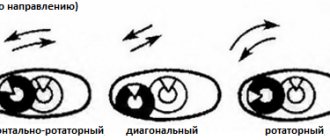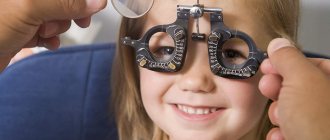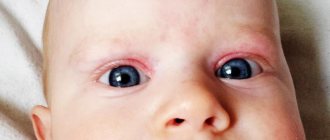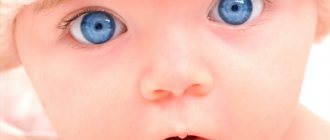Eye nystagmus in children: what it is, causes and treatment
Human eyeballs are always in motion. However, if their fluctuations occur involuntarily and uncontrollably, then nystagmus is diagnosed. This condition can be either physiological or pathological.
Nystagmus is quite common in children. This visual impairment is determined visually, but is often asymptomatic at the initial stage, which makes timely diagnosis of the problem difficult.
In the absence of therapy, visual acuity decreases.
Features of childhood nystagmus
Nystagmus - what is it? This is an ophthalmological disease characterized by involuntary oscillations of the eyeballs in different directions. This visual impairment can develop at any age.
Immediately after the birth of a child, he cannot focus his gaze on a specific object; his eyes are constantly moving. This physiological nystagmus usually disappears after one month.
But if this does not happen, then deviations in the functioning of the central nervous system are diagnosed.
Nystagmus in a child is most often detected at the age of 3 months and usually manifests itself in a horizontal form.
Causes of pathology
Nystagmus occurs as a result of increased tone on one side of the labyrinth of the inner ear.
With normal functioning of the central nervous system and visual system, the vestibular analyzer sends a signal to both eyes at the same speed.
And with nystagmus, hypertonicity of the labyrinth is formed, as a result of which the synchronization of signals occurs. This leads to the fact that the eyeballs begin to make involuntary movements in different directions.
In childhood, this ophthalmological disease is most often congenital in nature, arising for the following reasons:
- genetic predisposition;
- birth injuries;
- infection in the prenatal period;
- smoking and alcohol consumption by the mother during pregnancy.
Acquired nystagmus in a child can develop against the background of the following pathological conditions:
- infectious diseases;
- albinism;
- optic nerve atrophy;
- retinal dystrophy;
- oncological processes;
- traumatic brain injury;
- brain diseases;
- eye refractive error;
- damage to the vestibular apparatus.
Sometimes the cause of the pathological deviation cannot be detected.
Symptoms
The main manifestation of nystagmus in children is rapid and uncontrolled movement of the eyeballs, which can be noticed if you observe for a while. The direction and amplitude of vibrations may be different.
In the presence of such a visual deviation, the child unconsciously tries to assume a certain position of the head, in which the nystagmus is significantly reduced or disappears completely.
Usually the baby tilts or turns his head in the direction of rapid movements of the eyeballs.
A child with nystagmus cannot focus his gaze on one object and has a more difficult time adapting to changes in his environment. The speed of oscillatory movements increases with fatigue, severe anxiety and a stressful situation. This disease is accompanied by the following symptoms:
- feeling of constant movement of objects;
- impaired coordination and movement in space;
- decreased muscle tone;
- dizziness;
- nausea.
Often, along with nystagmus, strabismus and diplopia develop. Sometimes hearing impairment is observed.
Nystagmus in newborns
Nystagmus in a child usually occurs in the first 3 months of the baby’s life. If the visual deviation did not appear before this time, then in the future it can only have an acquired character. If signs of the disease appear in a newborn baby, treatment is not carried out. In this case, the child is registered with a pediatric ophthalmologist and remains there until he reaches 1 year of age.
All this time, the disorder is considered a temporary physiological phenomenon, the etiology of which is not possible to identify. And only if the symptoms of nystagmus do not go away by 12 months, a detailed examination is prescribed and therapy is carried out.
Types of disease
Depending on what period of life the problem arose, nystagmus in children is of 2 types:
- Congenital. Appears in the first 3 months after the birth of a child.
- Acquired. Develops under the influence of negative factors at any age.
By nature, the disease is divided into physiological and pathological. In the first case, visual impairment occurs when observing fast moving objects. A similar condition can be observed while riding on attractions, quickly moving the gaze from one point to another, as well as when water gets into the ear canal or an infection of the inner ear.
Sometimes involuntary eye movements occur due to severe fatigue, when the child tries to focus his gaze on one object. This phenomenon is temporary and does not require treatment.
Pathological nystagmus occurs against the background of various diseases of the central nervous system, vestibular apparatus or visual system.
Depending on the direction of movement of the eyeball, there are several types of pathology:
- Horizontal nystagmus . The eyeballs move left and right.
- Vertical . Oscillations occur from bottom to top and vice versa.
- Diagonal . The eyes move diagonally.
- Rotary . The eyeballs rotate in a circle.
Diagnostics
Nystagmus in a child can be noticed if you observe his behavior for some time.
However, at the initial stage of development, signs of deviation may not be observed or may have a mild form, which makes timely diagnosis of the pathology difficult.
If you suspect involuntary eye vibrations, you should contact a pediatric ophthalmologist, who will assess your vision and perform a simple test to confirm the presence of the problem.
The essence of this test is that the doctor asks you to focus your gaze on the pen, and then begins to quickly move it around, observing the movements of the eyeballs. After the diagnosis has been confirmed, it is necessary to undergo a series of studies to identify the extent of the disorder, identify the cause and select treatment. The most commonly prescribed diagnostic methods are:
- radiography;
- CT or MRI of the brain;
- electroencephalography;
- refractometry;
- Electronystagmography.
Additionally, a blood test is taken.
Treatment
Treatment of nystagmus in a child depends on the cause of the disease and the degree of its neglect. Congenital abnormalities in children under one year of age often go away on their own, but the acquired condition requires long-term complex therapy, which is not always effective. Treatment of nystagmus in children can be carried out in the following ways:
- Drug therapy . Drugs are selected to eliminate the root cause (antibiotics, muscle relaxants, neurotropics, anti-inflammatory drugs). Auxiliary medications are also prescribed to improve eye nutrition, dilate blood vessels, and so on. The most commonly used drops are Actovegin, Trental and Cavinton. Sometimes botulinum toxin injections are given.
- Optical correction. Glasses or contact lenses are selected that can correct visual acuity and the position of the eyeballs.
- Pleopathic treatment. The retina of the eye is stimulated by performing a variety of exercises. To improve the accommodative abilities of the eyes, computer tests and the use of special devices and filters are usually prescribed.
Is it possible to cure nystagmus at home?
It is impossible to cope with nystagmus in children on your own; no traditional medicine recipes can help cope with such a problem.
Therefore, you should not search for such information on the Internet and try various untested remedies offered. Otherwise, the consequences can be extremely unpleasant.
At home, you can only perform various exercises prescribed by your doctor.
Prevention
There is no special prevention for nystagmus in children. In order to prevent the development of such a problem in a child, it is necessary to lead a healthy lifestyle during pregnancy and ensure that the diet is balanced.
In what cases should you sound the alarm and contact an ophthalmologist?
If the child’s strabismus does not go away after reaching the age of three months or the parents suspect that the child’s eye mobility is impaired, then it is necessary to urgently contact a pediatric ophthalmologist or neurologist, because in some cases the problem may lie in the baby’s nervous system.
It is also necessary to consult a doctor in the following cases:
- purulent discharge from the child’s eyes;
- redness, increased tearing and swelling of the eyelids;
- “sour” eyes after sleep;
- pupils of different diameters;
- lack of reaction to light;
- the child does not follow the movement of an object after two months;
- twitching, running, blinking of the pupils, inability to gaze at a certain point;
- inability to focus on nearby objects (starting at two months of age);
- eyes are too bulging, “bulging”;
- contact with the eyes of any substances or foreign bodies;
- eye injury.
The doctor will determine the optical structure of the eye and, if necessary, prescribe glasses for the child, but they can only be worn after the baby reaches nine months of age.
In order to avoid any problems with the baby’s vision, it is necessary to regularly carry out hygiene procedures from the first days after birth, to protect the baby from the TV or computer monitor (at least up to a year). Excessive strain on a baby's eyes can harm his vision.
Nystagmus in newborns and children over 1 year of age
Nystagmus is a pathological condition in which spontaneous vibrations of the eyeballs in different planes are observed.
It is observed in newborns and children over one year old.
It can be caused by improper habits of the mother during pregnancy (smoking, inhaling harmful substances), insufficient nutrition or provoked by ophthalmological diseases, imperfections of the nervous system.
Depending on the nature, nystagmus can be physiological or pathological. In the first case, it occurs when the gaze suddenly shifts from one object to another. It goes away quickly and does not require treatment. In the second case, the disease requires diagnosis and complex therapy. It includes the fight against nystagmus and its causes (for example, myopia or farsightedness).
There are no preventive measures to prevent the occurrence of nystagmus in newborns that will protect against the condition. However, during pregnancy you should carefully monitor your health.
Causes of nystagmus in children
Most often, the disease is diagnosed by an ophthalmologist during an annual examination. Before this age, children may experience involuntary swaying of the eyeballs and an inability to focus on an object, which is not always a pathological condition. Up to three months, sometimes older, the eye muscles are not yet formed.
Children may experience congenital or acquired nystagmus due to the following factors:
- heredity;
- postpartum trauma;
- disorders of the nervous system and stress;
- nearsightedness (myopia);
- farsightedness;
- optic nerve atrophy;
- astigmatism and other diseases and pathologies of the visual organ;
- infectious processes in the ear;
- improper lifestyle of a pregnant woman - use of drugs and psychotic substances, teratogenic and potent medications (prohibited for use during pregnancy and negatively affecting the development of the fetus);
- albinism;
- tumor neoplasms.
Risk group
At risk of developing nystagmus are premature babies, babies born and raised in unfavorable conditions, with pathologies of the nervous and visual systems.
Types of nystagmus
There are congenital and acquired forms of the disease. The first type is found in newborns and is diagnosed closer to the first year of life during a routine examination by an ophthalmologist. The second type of nystagmus manifests itself in older children and adults under the influence of provoking factors.
Physiological and pathological forms are also distinguished. The first occurs in newborns due to underdevelopment of the optic nerve and does not require correction, only observation for up to a year. The second must be treated from the age of one year.
According to another classification, there are 7 types of nystagmus depending on the trajectory of the spontaneous movement of the eyeballs:
- horizontal;
- vertical;
- diagonal;
- rotary – clockwise or counterclockwise;
- Converging - in the direction of the eyes to each other;
- pendulum-shaped - in all directions with the same amplitude;
- dissociated - movements are carried out in different directions.
Depending on the cause, nystagmus occurs:
- vestibular – the vestibular apparatus suffers, nausea and dizziness, spontaneous attacks of twitching of the eyeballs are observed;
- central - caused by brain damage, tumor.
Features of nystagmus in newborns
In the first days of life and up to about 3 months, the eye muscles do not yet fully perform their functions. A horizontal nystagmus phenomenon may occur because the newborn is unable to focus on an object. This condition is of a physiological type and should pass.
If symptoms persist after the first month of life, the condition is pathological and requires observation by an ophthalmologist, neurologist and pediatrician for up to a year. It can be caused by neurological reasons, impaired functions of the nervous system, vestibular apparatus.
It is possible to determine the presence of the disease at 3 months, when the optic nerve is sufficiently developed. This is the time when the disease develops at its peak.
Features of nystagmus in children aged 1 year and older
This category may have one of two types of disease:
- congenital (detected from 3 months);
- acquired.
The second type is provoked by lesions and diseases of the organ of vision (for example, strabismus, myopia, farsightedness), neurological pathologies. It requires correction and reduction or elimination of provoking factors.
Up to 2-3 years of age, it is very difficult to diagnose the condition, because the child cannot assess many symptoms and correctly describe them - dizziness, nausea and others.
Forecast
The prognosis is favorable with timely consultation with specialists - a pediatrician, ophthalmologist and neurologist. The younger the patient and the sooner actions are taken to eliminate the disease and provoking factors, the faster the symptoms of nystagmus will pass.
Features of vision of a newborn
There is another misconception that a newborn sees a picture upside down. In fact, the retina of a baby’s eye, due to an insufficiently formed visual analyzer, displays the image upside down, but it is not completely turned upside down by ninety degrees. This way the image shifts only a little.
A baby who has just been born distinguishes light, the outlines and shadows of large objects, the mother’s face and everything that is located at a distance of no more than thirty centimeters from his eyes. A newborn's eyes may also squint slightly and most often this is not a cause for concern. But most often, the baby’s eyes, closing on the bridge of the nose or looking in different directions, return to normal and the movements of both pupils are completely coordinated. In the first few weeks of his life, the baby sees everything in black and white, but soon begins to distinguish bright colors, starting with red, yellow, green and blue, and then gradually other colors.
Nystagmus in a child: what is it, causes, treatment of the disease before and after one year
Nystagmus is the involuntary movement of the eyeballs in different planes and directions .
This visual pathology often manifests itself in childhood and even in newborns ; it can be visually determined immediately.
This disease can be pathological (develops against the background of various ophthalmological and neurological disorders) and physiological.
In the second case, nystagmus may appear even with a sharp shift of gaze to different objects , but usually this condition quickly passes.
Children's nystagmus and its features
Know! Newborn babies in the first month of life cannot fix their gaze on objects, and the baby's eyes are constantly moving, which can be mistakenly perceived as nystagmus.
However, after a month, the gaze fixation processes return to normal.
If this does not happen, we can talk about a dysfunction of the central nervous system or vestibular apparatus.
The peak development of nystagmus in children usually occurs in the third month of life.
And most often, the pathology manifests itself in a horizontal form (eye movements to the sides along a horizontal plane), while the intensity and amplitude of vibrations may differ in different patients.
In childhood, acquired nystagmus may also appear, the cause of which mainly lies in various lesions and diseases of the visual organs.
Often, nystagmus develops to a mild degree with a slight strabismus, and if it is eliminated or goes away on its own, the nystagmus also disappears.
Features of nystagmus in children under one year old
In newborns, nystagmus either develops before three months, or with an already formed visual system, by this age the pathology does not develop at all.
Note! If in infants and children under one year old objective symptoms allow us to draw conclusions about the presence of nystagmus, immediate treatment is not required, as is the case with adult patients.
In such cases, children are registered and observed by an ophthalmologist, pediatrician and neurologist until they are one year old.
At the same time, a violation during this time is a priori considered a temporary non-pathological deviation, because it is impossible to identify the real causes even with some provoking pathologies.
Treatment, if necessary, begins only after reaching the age of one year.
Causes
Nystagmus in children can develop for the following reasons :
- infectious diseases of the inner ear,
- hereditary factors
- severe stress,
- manifestations of albinism,
- atrophic pathologies of the optic nerve,
- existing farsightedness or myopia,
- strokes,
- dystrophic lesions of the retina,
- cancerous formations in the brain or eye area,
- astigmatism.
In the case of newborns, gestation conditions play an important role
Thus, nystagmus can appear in a child due to birth injuries to the head and organs of vision, or develop in the womb if the expectant mother uses alcohol or drugs during pregnancy or is undergoing treatment with potent drugs.
What is strabismus in a newborn?
Immediately after birth, the child begins to adapt to the world around him and learns to control his body. While in the womb, the baby does not have the opportunity to acquire skills related to the organs of vision, so the formation of their functions to a greater extent occurs after birth.
The first few weeks, and sometimes months, a connection is established between the brain centers responsible for vision and the eyes themselves. During this period, a child who is not yet adapted to a full life cannot always control eye movements. That is why they often behave inconsistently.
Up to two months, slight asymmetry of the pupils is considered normal.
The imaginary effect of strabismus can occur due to the peculiarities of the location of the bones of the child’s skull or the skin folds in the corners of the eyes. The baby's facial features quickly change and take on a more regular shape, so within a month the apparent defect disappears.
In most cases, strabismus (or strabismus) in newborns is not a pathology, but a natural condition. It is definitely impossible to diagnose strabismus in the first month of life. The pupils are finally established by two, less often by six months. If after six months the defect does not go away on its own, this may indicate true strabismus, which needs to be treated.
If strabismus persists after six months, you need to sound the alarm
If there are concerns about congenital eye pathology, you should regularly visit an ophthalmologist. Newborns are examined by specialists in the maternity hospital in the first hours after birth. Routine examinations for suspected strabismus are carried out at two, four and six months. The doctor determines the dynamics of the development of the defect and by six months makes a decision on the need for treatment.
Video: strabismus in children
Possible causes of nystagmus in infants: types, diagnosis, prevention of the disease
A child's eyes begin to actively develop during the prenatal period. If a newborn's eyes move around, this may indicate a disruption in normal development. The earlier the pathology is diagnosed, the easier it is to treat.
A newborn's eyes are darting
Changes in vision in the first month
In the first weeks of his life, a child sees completely differently from an adult. The baby's eyeball has a flattened shape and grows quickly. His retina is not fully formed. There is no central vision due to the absence of the macula. The baby cannot see three-dimensional objects and estimate the distance to them.
Note! A child can sometimes develop what is called infantile strabismus. This occurs due to weakness of binocular vision or in cases where the woman led an unhealthy lifestyle during pregnancy.
Also, in the first months, children perceive the world around them in black and white and do not distinguish between colors. The first color that children begin to see is red.
Changes in vision up to one year
Why does a newborn roll his eyes when falling asleep or during sleep?
Normal vision changes in babies are:
- At one month of age, a child is able to see shadows and light and the outlines of large objects at close range. He sees his mother's face more clearly.
Important! At this time, it is important to check the pupil's reaction to light.
- In the first 3 months, the sensitivity of the retina increases sharply and the ciliary muscles become stronger. The child can steadily fix his gaze on moving objects and distinguish between red and green colors.
- At the age of 4-6 months, active development of vision occurs. A macular spot forms and the eyes' sensitivity to light increases.
- Before the child reaches one year of age, the final formation of binocular vision occurs.
Children under one year old cannot have 100% vision. Their eyes get tired even after a slight load. Visual acuity finally returns to normal by the age of one year.
The eye of a premature baby is immature and has an incomplete anatomical structure. Premature babies are at risk for developing retinopathy and visual impairment. All premature babies should be examined by an ophthalmologist no later than the fourth week of life.
Why does a child's eyes shift?
Discharge from the eyes of a newborn - causes of mucus
Nystagmus is involuntary eye movements. They cause the cerebral cortex to receive incorrect and unclear information.
Reasons why a child's eyes dart:
- birth injury;
- a brain tumor;
- damage to the vestibular apparatus;
- albinism (a genetically determined disease in which there is no melanin pigment in the iris, skin and hair);
- refractive error of the eye (myopia or farsightedness);
- strabismus (it is noticeable how the newborn’s eyes are directed in different directions);
Strabismus in a baby
- pathology of the optic nerve;
- destructive processes with the retina in the eye shell;
- infectious diseases, including in the inner ear.
How to check your baby's vision
Simple procedures are used to test your vision at home.
In the first 2 months, the newborn’s reaction to its own appearance should be observed. You need to approach the baby at a distance of about 20 cm. The child must react (for example, smile). This can also be done after sleep.
After a month, you should offer your baby bright yellow or red toys. If his vision is formed correctly, then he will certainly pay attention to them. After another month, the baby should be interested in toys of cool colors: blue or green.
From the age of five months, you need to show the child objects alternately: at close or far distances. If vision develops normally, the baby will fix his gaze on the toy. You should also show bright circles.
Toy for child
Dr. Komarovsky recommends checking by observation:
- does the baby concentrate his gaze on the toy at the age of 1 month;
- does he close his eyes from a bright light source;
- whether he recognizes his parents by the age of three months.
Important! During the vision test, there should be sufficient lighting in the room.
Before one year of age, it is impossible to determine visual acuity using the Sivtsev and Orlova tables.
When to visit an ophthalmologist
Parents should urgently contact a pediatric ophthalmologist if they have the following symptoms:
- pupils of different diameters;
- in bright light they do not narrow;
- the eyes began to turn red;
- after 2 months of age, the child does not fix his gaze on any object;
- physiological infant strabismus does not go away by 4 months of age;
- a cloudy pupil is detected;
Baby's cloudy pupils
- the child does not show interest in objects of yellow, red, blue and green colors;
- The toddler does not try to grab the object he is looking at, does not react to it (including does not grunt).
Prevention of visual ailments
In order to prevent the development of nystagmus, vision training plays an important role. The main stimulus is the abundance of sunlight. The children's room should have a window facing the sunny side. It is important to have toys that the child can easily reach.
Until the age of three months, it is important to conduct training sessions. You should purchase cards with large black and white images of objects. It is recommended to fix some of them above the crib. It is useful to hang a baby mobile above the crib. The child will be able to look at it while feeding or when falling asleep.
Mobile for baby
From three months, pictures should be in color. They contribute to the development of correct color perception.
It is recommended to listen to the following advice:
- In addition to sufficient sunlight, the room should have good electric lighting.
- Until the age of three months, toys should be placed above the crib (or stroller) at a height of 40-50 cm;
- From two months onwards, it is recommended to place the baby on his stomach. This will promote vision development.
- When falling asleep, the light should be dimmed.
Nystagmus in newborns develops for natural or pathological reasons. Parents should closely monitor vision development. If even the slightest deviations appear, for example, abnormal movement of the eyes, the baby should be shown to a doctor. Eye diseases need to be treated as early as possible.
Normal vision in a newborn
A newly born baby has congenital farsightedness, which occurs due to the fact that the size of the baby’s eye is somewhat flattened in anteroposterior size, as a result of which the image is projected further than the retina. A newborn has low visual acuity; the acuity index reaches 0.01 only at the end of the first month of his life.
Reaction to light
The baby’s meaningful reaction to light appears from 2-5 weeks.
By this time, the child is able to highlight the luminous surface and fix his gaze on it for a short time. But the baby is not adapted to bright light, his light sensitivity is reduced. Under the influence of light, a newborn reflexively closes his eyes and throws his head back.
Colors
It is also normal that a newborn cannot distinguish colors. This ability appears in him only at the age of 2.5-3 months.
Strabismus
Almost all children in the first month of life have strabismus. This is also not a pathology, since the baby’s eyes have not yet learned to move and react to the world around them at the same time. However, strabismus can also be caused by serious reasons, which only a specialist can determine.
Causes of nystagmus in a newborn baby
IT IS IMPORTANT TO KNOW! An effective remedy for restoring vision without surgery or doctors, recommended by our readers! Read more…
Nystagmus is a disease in which spontaneous vibrations of the eyeballs occur. Such movements are not controlled by either the brain or the optic nerve. The effect of a constantly running gaze is created and the child is not able to fix visual objects. Nystagmus in newborns develops over time.
After all, after birth, babies’ vision is still poor, and their gaze is still wandering. Only after the first month of life does the child learn to fixate on objects. If the gaze has not clearly formed, doctors can make a preliminary diagnosis - nystagmus. At 3 months the disease is confirmed and observed for up to a year.
After all, such a deviation in most cases is considered temporary and can go away on its own if no pathology is detected.
Causes of nystagmus
Most often, this type of eye disease is diagnosed a year during the first preventive examination in a children's clinic. It is at this age that involuntary fluctuations of the eyeball and the inability to focus on an object or object are considered a pathology. The following factors provoke nystagmus in children:
- hereditary predisposition of the child;
- congenital disorders of the nervous system or their appearance as a result of injuries during birth;
- myopia;
- traumatic brain injuries;
- infection in the ear and, as a result, illness;
- taking medications by the expectant mother that are prohibited during pregnancy;
- parental use of drugs and alcohol before conception and during the entire course of pregnancy by the mother.
In an adult, the disease can be provoked by stress and nervous tension. Therefore, it is so important to conduct an examination not only with an ophthalmologist, but also with a neurologist at the first symptoms.
What types of nystagmus are there and how does it manifest?
In ophthalmology, the following types of eye diseases are distinguished:
- Horizontal nystagmus. With this shape, the eyes move from right to left;
- Vertical. In this case, the eyeballs move alternately from bottom to top and back;
- Pendulum-shaped. The eyes move with the same amplitude in all directions;
- Dissociated. Eyes move in different directions.
Another classification of nystagmus divides it into acquired and congenital. Acquired is more common in adults. In children, the disease has a congenital form.
In the first year of life, a child will not be able to explain what is bothering him. Parents should closely monitor the baby themselves.
Signs of congenital nystagmus, in addition to a shifting gaze, are increased photosensitivity and decreased level of vision.
Also, the disease of the visual apparatus is manifested by the following symptoms:
- constant dizziness;
- attacks of nausea;
- hearing impairment;
- lack of coordination in space and the sensation of objects moving around.
The manifestation of all signs of the disease depends on the stage of nystagmus. For example, if the disease is at the very beginning of its development, it is not at all noticeable to others. When the eye is motionless, there are no vibrations.
They appear only when the child’s eyes are strongly moved to the left or right. The average degree of the disease is characterized by already visible movements of the eyeballs when the baby looks straight.
In the most severe form, oscillations occur even during slow abduction of the eye to the sides.
With congenital nystagmus in newborns, fluctuations are observed in the second month of life. Involuntary movements and poor focusing on an object for up to a year are the norm. But it is necessary to consult with a specialist so as not to miss the possible pathology that causes the disease.
How is nystagmus diagnosed?
In order to ensure the accuracy of the disease and exclude others, the patient must undergo a complete examination. The diagnosis is made by a neurologist after the following studies
- amplitude of rotation of the eyeball;
- complete examination of the retina;
- Brain MRI.
In addition, an acuity check with an ophthalmologist and consultation with him are prescribed. If necessary, the child is referred for examination to an otolaryngologist.
We recommend!
To treat eyes without surgery, our readers successfully use a proven method. Having carefully studied it, we decided to offer it to your attention. Read more…
How is nystagmus treated?
As a rule, treatment of nystagmus in children is a whole complex of long-term procedures, also aimed at getting rid of the pathology and disease that causes eye disease.
Glasses are prescribed only to those children whose nystagmus has caused myopia or farsightedness. Modern medicine carries out therapy using special devices, the action of which is aimed at stimulating the level of vision in the baby. This course is held a couple of times a year and lasts three weeks. Through surgery, doctors reduce the amplitude of eye oscillations to a minimum.
Throughout the treatment, the child is registered in a special institution from the moment the disease is diagnosed until the age of 15. During this long time, doctors try to improve vision as much as possible and reduce the amplitude of eye rotation. Treatment is effective at an earlier age. This is why it is so important to identify nystagmus as soon as it appears.
A fairly common occurrence is the development of one eye disease into another - myopia. This happens at the moment when the baby is just learning to keep his gaze on individual objects.
Prevention of nystagmus in children
It is quite difficult to protect the baby from such an eye disease. But it is up to parents to promptly treat diseases of the ENT organs, and also to prevent the development of serious diseases throughout the child’s body. Try to examine the child’s brain and nervous system as often as possible so as not to miss pathological formations.
If, as a result of visual impairment, the child was prescribed glasses, be sure to buy them and let the child wear them, find the right words, tell them how important it is. Most importantly, teach your child not to be embarrassed about wearing glasses, so that complexes do not arise in the future. If you do not adhere to this doctor’s recommendation, the baby will soon develop nystagmus.
Congenital nystagmus in a newborn is almost impossible to prevent. It is impossible to completely insure a baby against injuries during childbirth and infections. But a woman is able to significantly reduce the risk of developing pathology if she monitors her health during pregnancy, trying to constantly strengthen her immunity.
Any child can suffer from nystagmus due to certain reasons. This does not make him some kind of weak-minded; his physical development does not lag behind his peers. The baby will just need to undergo certain procedures and, if necessary, wear glasses for vision correction.










